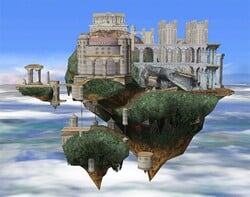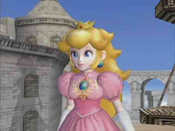Temple: Difference between revisions
(→Trivia) |
No edit summary |
||
| Line 17: | Line 17: | ||
Announced at [[E3]] 2001, '''Temple''' is a [[stage]] in ''[[Super Smash Bros. Melee]]'' and is one of the [[Melee Stages]] in ''[[Super Smash Bros. Brawl]]''. It is commonly known as '''Hyrule Temple''' (this name appears in [[Melee]]'s instruction booklet at page 44), though its proper name is Temple (since "Hyrule" denotes Temple's location). An extremely large stage, it is banned in most [[tournament legal (SSBM)|tournaments]] because its size provides opportunities for game-[[broken|breaking]] camping and stalling. | Announced at [[E3]] 2001, '''Temple''' is a [[stage]] in ''[[Super Smash Bros. Melee]]'' and is one of the [[Melee Stages]] in ''[[Super Smash Bros. Brawl]]''. It is commonly known as '''Hyrule Temple''' (this name appears in [[Melee]]'s instruction booklet at page 44), though its proper name is Temple (since "Hyrule" denotes Temple's location). An extremely large stage, it is banned in most [[tournament legal (SSBM)|tournaments]] because its size provides opportunities for game-[[broken|breaking]] camping and stalling. | ||
This stage has no hazards. | This stage has no hazards. | ||
Its main theme is an orchestral arrangement of one of the Temple themes from ''[[Zelda II: The Adventure of Link]]''. In ''Melee'', its alternate theme is a medley of two songs from the ''[[Fire Emblem (universe)|Fire Emblem]]'' series: the character recruitment theme from games one, four, and seven in the series, and the title screen theme that is heard in every game. Both the ''Zelda'' and ''Fire Emblem'' series feature protagonists who wield swords and take place in medieval-like settings. | |||
==In the [[Super Smash Bros. (universe)|''Super Smash Bros.'' series]]== | ==In the [[Super Smash Bros. (universe)|''Super Smash Bros.'' series]]== | ||
Revision as of 07:45, June 14, 2010
| Temple | |
|---|---|
| Temple as it appears in SSBM File:Triforce Icon.gif | |
| Universe | The Legend of Zelda |
| Appears in | SSBM SSBB |
| Availability | Starter (SSBM and SSBB) |
| Crate type | Normal |
Announced at E3 2001, Temple is a stage in Super Smash Bros. Melee and is one of the Melee Stages in Super Smash Bros. Brawl. It is commonly known as Hyrule Temple (this name appears in Melee's instruction booklet at page 44), though its proper name is Temple (since "Hyrule" denotes Temple's location). An extremely large stage, it is banned in most tournaments because its size provides opportunities for game-breaking camping and stalling. This stage has no hazards.
Its main theme is an orchestral arrangement of one of the Temple themes from Zelda II: The Adventure of Link. In Melee, its alternate theme is a medley of two songs from the Fire Emblem series: the character recruitment theme from games one, four, and seven in the series, and the title screen theme that is heard in every game. Both the Zelda and Fire Emblem series feature protagonists who wield swords and take place in medieval-like settings.
In the Super Smash Bros. series
The stage is one of the eighteen default stages available in Super Smash Bros. Melee. It is a Legend of Zelda stage on which characters from that franchise will usually battle the player in single-player battles. The layout seems to be based on the palaces from Zelda II: The Adventure of Link. In Melee's All-Star mode, this stage is played on when you face Zelda and any of her teammates.
In Super Smash Bros. Brawl the stage has lost the possibility of playing the "Fire Emblem" medley theme from Melee (the song has moved to the Fire Emblem-themed Castle Siege). A remix of "The Great Temple" theme from Zelda II: The Adventure of Link can be obtained to play on this stage in My Music, making it the only Melee Stage that has a new piece of music available to play on it. In Brawl, the ledge on the right hand side can no longer be grabbed on the larger bottom platform as it could in Melee.
Fight Club
The underground area on the stage is referred to by Nintendo Power as the "Fight Club". It is termed so because battles there tend to produce disproportionately high damage totals, due to the fact that the surrounding environment keeps the opponent from leaving the stage or being knocked out easily. The ease in which a high-damage opponent can survive in the Fight Club can often lead to players turtling inside. The area is also known by a variety of other nicknames by players.
Origin
Temple is based off of Zelda II: The Adventure of Link. In The Legend of Zelda: Ocarina of Time, the name of the dungeons is based off of the type of environment around it or the location with "Temple" at the end. However, in Zelda II, these dungeons are called "Palaces". Hyrule is where the Temple is located, hence "Hyrule Temple". Also the palaces in Zelda II are infamous in length, which could explain the size of the stage. The music for Temple is a redone version of the Palace theme from Zelda II.
In Zelda II's overworld map, a Palace looks like a rooftop supported by three pillars. In the background of the stage, you can see a building like this on top of the hill except it has more than three pillars.
Competition
Temple is the stage that is most often incorrectly considered among a list of completely fair stages. In fact, most high level players will attest that Temple is among the most unfair stages in the game. Its immense size gives an extreme advantage to fast characters with projectiles (i.e. Fox) and the Fight Club completely revamps the way the game is played. Most of the misconceptions about its fairness come from newer players who see the large size as a way to allow them to live longer. While this is true to a degree, the upper blast lines are nowhere near as stretched as the side ones. This again give a distinct advantage to characters who have the most knockback in the upwards direction, but completely devalues a character whose knockback is in side to side directions. This being said, Temple is banned in high level tournaments because it forces the game to take on a role completely different from any other stage.
Hyrule Jump
- See Hyrule Jump for more information.
Because of its size, Temple is the arena of such feats as the Hyrule Jump and, as of SSBB, gliding completely around the stage.
Trivia
- If Sheik's Chain is used in the correct spot in the tunnel of the stage, the tip of the chain will stick to the roof of the tunnel and make a straight line from her hand to the roof. This is sometimes referred to as the Sticky Chain Glitch.
- It is possible for Pit, Meta Knight and Charizard to perform a Full Circle Jump here, in which they glide around the entire stage, starting at the left side and going in a counter-clockwise direction, or the top platform of the right side and going clockwise.
- In Melee, there is a glitch with CPU Jigglypuff and Kirby. If smashed off the left side of the lower part of the stage, the character will attempt to return using its multiple second jumps, but will sometimes get stuck on the slight overhang above. This is usually not fatal to Jigglypuff, as it will often glide back to the platform after its jumps are exhausted, but Kirby will use his Final Cutter and fall straight down for a SD.
- In the "Special Video" of Melee, during two clips of Temple, two odd platforms can be seen, which do not appear on the stage in Melee or Brawl. The same platforms can be seen in the short video clip after beating a single-player mode as Luigi as well as in the manual's picture depicting Fixed-Camera Mode.
- Along with the platforms, early versions of the game featured an elevator to lead to the bottom of the stage; this does not appear in the finished form of the game.
- If Pokémon Trainer is chosen, he stands on top of the arches in the middle section of the stage.
- This also has another AI glitch, where fox as a level 9 CPU, cannot escape from the lower part of the stage. This was fixed in Brawl.
Gallery
Roy and Marth in Temple in Super Smash Bros. Melee
- Stage18 071130a-l.jpg
- Stage18 071130c-l.jpg
- Stage18 071130d-l.jpg
| Stages in Super Smash Bros. Melee | |
|---|---|
| Starter stages | Brinstar · Corneria · Fountain of Dreams · Great Bay · Green Greens · Icicle Mountain · Jungle Japes · Kongo Jungle · Mushroom Kingdom · Mute City · Onett · Pokémon Stadium · Princess Peach's Castle · Rainbow Cruise · Temple · Venom · Yoshi's Island · Yoshi's Story |
| Unlockable stages | Battlefield · Big Blue · Brinstar Depths · Final Destination · Flat Zone · Fourside · Mushroom Kingdom II · Poké Floats |
| Dream Land · Kongo Jungle · Yoshi's Island | |


